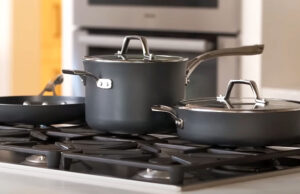As an Amazon Associate, I earn from qualifying purchases at no extra cost to you.
How to Secure a Dishwasher Without Clips: Expert Tips
You know that feeling when your dishwasher starts to move around every time it runs? It’s a hassle, right? Well, don’t worry! In this article, I’ll show you how to secure your dishwasher without needing clips. It’s simpler than you think, and you don’t need to be a pro to fix it. By the end of this, your dishwasher will stay put, no matter how much it shakes.
Why It’s Important to Secure Your Dishwasher Properly
When you install a dishwasher, it needs to be stable and securely attached to its spot. If it moves around or rocks during operation, it can cause damage to both the appliance and your kitchen. Plus, it can lead to leaks, water damage, or even break parts of the machine. So, securing your dishwasher without clips is not only essential for your appliance’s longevity but also for safety.
The Risk of an Unstable Dishwasher
An unstable dishwasher can create several issues. First, when the machine isn’t stable, it can start to shift during cycles, especially the spinning and washing phases. This movement can damage the internal components, such as the spray arms or drain pumps, and wear them out faster than usual. Second, water leakage is another big problem. If the dishwasher isn’t sealed properly due to instability, water may seep out during its wash cycle, which can lead to water damage on your kitchen floor or cabinets.
Long-Term Benefits of Securing the Dishwasher
Securing your dishwasher ensures it runs efficiently for a long time. By preventing movement, you reduce the strain on the appliance’s parts, which can help avoid expensive repairs. Furthermore, a properly installed and stable dishwasher is safer and performs better, saving you energy in the long run. Plus, you’ll have peace of mind knowing that it’s less likely to leak or cause other problems.
Methods to Secure Your Dishwasher Without Clips
While dishwasher clips are one of the most common methods for securing these appliances, they aren’t the only solution. There are several simple methods you can use to keep your dishwasher in place without relying on clips. Let’s explore these options in detail so you can choose what works best for your kitchen.
1. Adjust the Dishwasher Legs
Most dishwashers come with adjustable legs that allow you to change the height and level of the appliance. The first step in securing your dishwasher is to make sure it’s properly leveled. You can do this by adjusting the front or rear legs until the appliance sits flat against the floor. This will help to minimize movement during use.
To adjust the dishwasher legs, start by pulling the appliance slightly out of its spot. Use a wrench to adjust the legs as needed, either raising or lowering them to ensure that the dishwasher is perfectly level. Once you’ve adjusted the legs, gently push the dishwasher back into place. A level dishwasher reduces the chances of it shifting during a wash cycle.
2. Use Anti-Slip Mats or Pads
One of the easiest and most effective ways to secure your dishwasher is by using anti-slip mats or pads underneath it. These mats are designed to grip the floor and keep your dishwasher from shifting, even during heavy cycles. They’re available in a variety of materials, such as rubber or foam, and can be cut to fit the size of your dishwasher’s base.
To install anti-slip mats, simply lift the dishwasher and place the mat underneath it. If your floor is uneven, these mats will help to stabilize the appliance. You can also use rubber pads on the corners to prevent the dishwasher from moving. This method is especially helpful for wooden or tile floors, where the dishwasher is more likely to slide around.
3. Secure the Dishwasher with Brackets or Straps
If you’re looking for a more secure option, brackets or straps can be used to hold the dishwasher in place. These are typically mounted to the walls of the kitchen or to the surrounding cabinetry. The straps are then looped around the dishwasher to keep it securely in place.
To install brackets or straps, you’ll need to drill small holes in the kitchen’s cabinetry or wall. The brackets are usually adjustable, so you can tighten them to create a secure fit around the dishwasher. This method is especially useful if you want a permanent solution to secure the dishwasher, and it’s often used in homes with more substantial or permanent kitchen fixtures.
4. Use Wood Blocks or Shims
In some cases, a few simple wood blocks or shims can be used to prevent your dishwasher from moving. These are placed under the dishwasher’s feet, especially if your kitchen floor is uneven. The blocks help to raise the dishwasher and keep it from shifting during its wash cycles.
To use wood blocks or shims, simply slide them under the dishwasher where the legs sit. They should be carefully placed to prevent the dishwasher from rocking back and forth. This method works best if your dishwasher is sitting on a floor that has noticeable dips or is uneven.
5. Install a Secure Mounting Kit
For a more professional and sturdy solution, consider installing a secure mounting kit. These kits are specifically designed to anchor the dishwasher to the surrounding cabinetry or floor, providing maximum stability. Mounting kits usually come with screws, brackets, and other hardware necessary to secure the dishwasher in place.
To install a mounting kit, start by following the instructions provided with the kit. Typically, this involves drilling small pilot holes into the cabinetry and securing the dishwasher with screws. Once it’s mounted, your dishwasher will be completely secure and less likely to shift or cause problems.
Troubleshooting Common Dishwasher Stability Problems
Even with the best installation techniques, you may run into some stability issues with your dishwasher. Here’s a guide to help you troubleshoot and resolve common problems that might arise.
1. Dishwasher is Still Shaking After Installation
If your dishwasher is still shaking even after you’ve installed anti-slip mats or adjusted the legs, the issue may lie with the floor itself. Uneven flooring can cause the dishwasher to become unstable. If this is the case, you may need to install additional shims or use thicker anti-slip mats to create a more stable base.
Another possible reason for shaking could be an improper load. A dishwasher that is overloaded or unevenly packed can cause vibration. Make sure you’re loading the dishwasher properly, distributing the weight evenly, and not overfilling it.
2. The Dishwasher is Not Fully Level
Sometimes, despite adjusting the legs, the dishwasher may still not be level. This could be because the legs aren’t securely in place or the floor is sloped. To fix this, double-check the legs and make sure they are tight and fully extended. If your floor slopes, try using a leveling compound or additional shims to balance the appliance.
3. The Dishwasher is Moving During Wash Cycles
If your dishwasher is still moving during its wash cycles, you might need to reinforce the brackets or straps holding it in place. Over time, these can become loose, causing the dishwasher to shift. Tightening the straps or adding extra brackets can help secure it further. In some cases, it may help to recheck the alignment of the dishwasher legs to ensure it is level.
I hope these methods and tips help you keep your dishwasher secure without the need for clips. Securing your dishwasher is an easy task that will save you from potential problems down the road. Take your time to try different methods and see which one works best for your space. With a little effort, you can have a stable and efficient dishwasher that runs smoothly for years!
Frequently Asked Questions (FAQs)
Is it necessary to secure my dishwasher without clips?
Securing your dishwasher is important for preventing damage to the appliance and avoiding water leaks. If you’re unable to use clips, alternative methods like adjusting the legs, using anti-slip mats, or securing it with brackets can work just as well to keep the dishwasher stable.
Can I use any type of mat to secure the dishwasher?
You can use anti-slip mats or rubber pads that are specifically designed to prevent movement. While any mat could technically work, using a purpose-built mat ensures better stability. These mats grip the floor and prevent the dishwasher from shifting during cycles.
Do I need to drill holes to secure my dishwasher?
Some methods, like using brackets or straps, require drilling holes into the kitchen’s cabinetry or floor. However, other options, like using anti-slip mats or adjusting the legs, do not require drilling. Choose the method that best fits your preference for installation.
Is it possible to fix an unstable dishwasher without professional help?
Yes, securing an unstable dishwasher is something you can do yourself with the right tools. Whether you’re adjusting the legs or using anti-slip mats, these methods are easy to follow and don’t require professional help unless you choose to install a more permanent solution like mounting kits.
Can I secure the dishwasher on an uneven floor?
Yes, securing a dishwasher on an uneven floor can be done by using shims or wood blocks to level the appliance. Anti-slip mats or pads can also help to stabilize the dishwasher. It’s essential to ensure that the dishwasher is level to avoid further issues.
Is it safe to leave my dishwasher unsecured?
Leaving your dishwasher unsecured can lead to leaks, internal damage, and instability. It’s always best to ensure the dishwasher is secure to prevent long-term issues. There are simple, cost-effective methods you can use to secure your dishwasher without the need for clips.
Do I need to remove the dishwasher to secure it?
It depends on the method you choose. For minor adjustments like leveling the legs, you won’t need to remove the dishwasher. However, if you are installing brackets or straps, you may need to pull the dishwasher out slightly to install the necessary hardware.
Is it possible to prevent water leaks by securing the dishwasher?
Yes, securing the dishwasher helps to prevent water leaks by ensuring the appliance stays in place. When the dishwasher shifts or becomes misaligned, it may cause gaps in the seals, which can lead to leaks. Securing it will help maintain proper alignment and prevent these issues.




